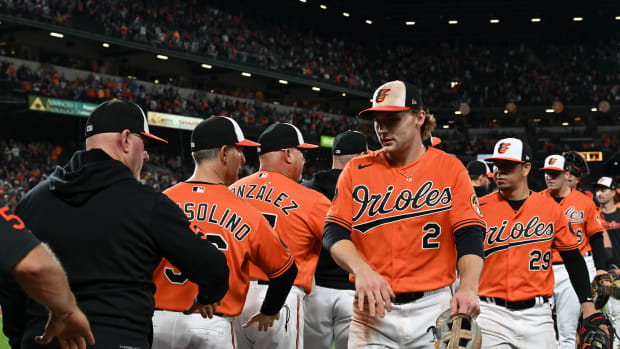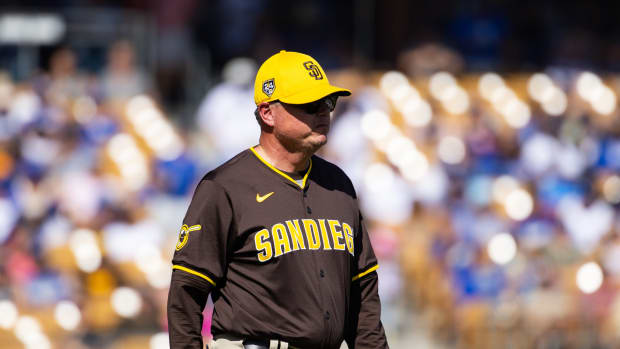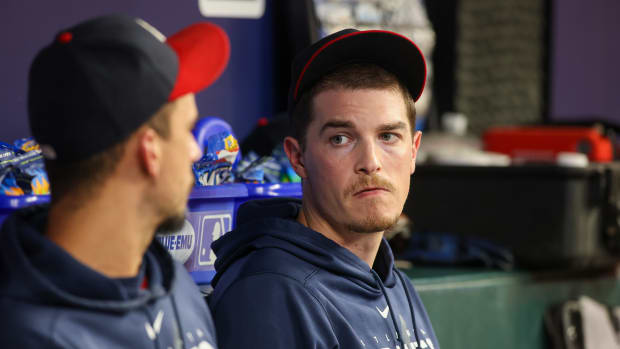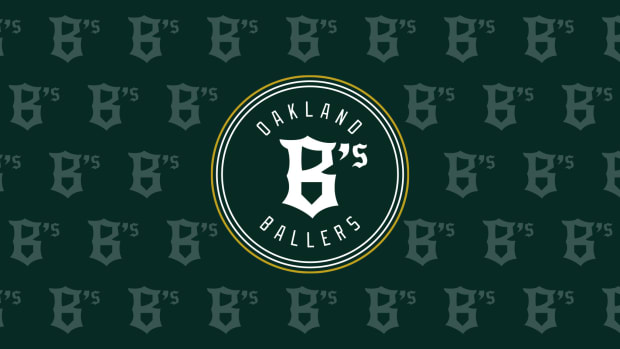Dodgers' Mega Trade Is More About 2018 Offseason Than Reacquiring Matt Kemp
After weeks of inaction, the Dodgers have finally made a blockbuster trade—albeit one that will have virtually no effect on their 2018 team or World Series chances. As first reported by The Athletic’s Ken Rosenthal, Los Angeles is sending first baseman Adrian Gonzalez, starters Brandon McCarthy and Scott Kazmir and infielder Charlie Culberson to the Braves for outfielder Matt Kemp. If you’re looking at that collection of names and wondering if you’ve somehow stumbled into 2011, you’re not alone. But the key to understanding this swap isn’t the talent being moved around, but the money changing hands—or, in the case of the Dodgers, being saved.
Not one of those five players will make any real difference to either Los Angeles or Atlanta next year. Kemp is the biggest name changing residences (and, in this case, going back to the team that drafted him 14 years ago), but he was a sub-replacement level player last year thanks to his brutal defense in leftfield and league-average bat; his -1.3 WAR was eighth-worst among all players in the game. Not that Gonzalez, Kazmir or McCarthy were any better: All were sidelined for long stretches with injuries, with Kazmir never even getting onto the mound in the majors. Gonzalez managed just 71 games thanks to back woes, lost his starting job to Rookie of the Year Cody Bellinger and hit only .242/.287/.355. McCarthy, who more or less lives on the disabled list, tossed just 92 2/3 innings last season—his third straight year under 100. In all honesty, the most impactful player in this deal might be Culberson, a no-hit/all-glove infielder who had an OPS+ of 34 (!) in part-time duty last year but improbably crushed the ball in the postseason in place of an injured Corey Seager, slashing .500/.471/.938 in 18 plate appearances.
This deal isn’t about the players, and neither team is even pretending that’s the case; the Braves will waive Gonzalez on Monday, making him a free agent, and the Dodgers are already reportedly looking to flip or release Kemp, who has no spot in a crowded outfield. Instead, this is one gigantic salary dump on both sides. Gonzalez, Kazmir and McCarthy are all entering the last years of their contracts and will make a combined $51.6 million in 2018. Kemp, meanwhile, still has another two years and $43.5 million left on his current deal. Los Angeles rids itself of three high-priced veterans who were unlikely to contribute to next year’s team while Atlanta dumps one of its biggest contracts in an expiring contracts trade that would make the NBA proud. The Braves also open up an outfield spot for top prospect Ronald Acuña and can flip McCarthy or Kazmir at the deadline for prospects should either or both get and stay healthy and productive.
But the biggest outcome of this deal is a dream scenario for Los Angeles. By trading Gonzalez, Kazmir and McCarthy and adding on Kemp, the Dodgers are now projected to have a payroll of roughly $185 million next year—$12 million under the luxury tax threshold of $197 million. If they can avoid surpassing that number, not only will they avoid a tax—a percentage of every dollar above that figure—but they’ll also no longer be repeat violators of it. Teams that surpass the threshold in consecutive years are subject to larger and larger penalties every season they go over, maxing out at 50% on the dollar at three years and up. By getting under $197 million, the Dodgers can re-set the penalty, creating a potentially gigantic windfall of cash going forward.
In essence, for the Dodgers, this is a trade for next winter, when the massive free-agent class of Bryce Harper, Manny Machado, Josh Donaldson, and Charlie Blackmon (and potentially Clayton Kershaw, if he opts out of his contract) will all hit the market at once. The money saved by getting under the luxury tax will theoretically be used to splurge next year. The rich, as they say, are getting richer. (And note that the Dodgers aren’t alone in doing this; the Yankees, despite adding Giancarlo Stanton, are also currently under the luxury tax, freeing them up to spend big in 2018 as well.)
This is a terrifying prospect for the rest of the league, with the great majority of teams already completely unable to match the Dodgers and Yankees (as well as a few others) dollar for dollar for top-flight free agents and even less able to do so if both teams suddenly come into some extra cash. But even though a good chunk of those spare millions will be thrown at Harper, Machado and the like, it’s also a worrisome development for the players, who have already seen the free-agent market grow cold this year as teams get more and more frugal. That $197 million luxury tax limit is essentially a soft salary cap, and one that seems to be growing harder. It’s not just the Yankees and the Dodgers steering clear of spending this winter. Other squads that are up against the cap—the Giants, Red Sox, and Nationals, to name a few—are leery of the financial hit that the overage tax will deliver.
All of that is bad news for the players, especially mid-tier free agents. Guys like Harper and Machado will get paid no matter what financial constraints exist; elite talent always will. It’s the players further down the food chain who will suffer, as teams decide to save their money and squeeze those on the market. You’re already seeing that this year: Aside from middle relievers, there’s been no movement for free agents, as teams seem content to wait the players out until they get desperate to sign whatever deal is on the table. And with the big spenders sitting free agency out for financial reasons, the players have no leverage.
It was easy to see this coming when the latest collective bargaining agreement was signed last December, as the luxury tax limit barely edged up year by year despite the league’s exploding revenues—$10 billion this year alone. Ever since the advent of free agency, which MLB owners fought against tooth and nail for decades, front office executives have decried the rise in player salaries; with MLB as the only major North American sports league without a salary cap, there’s theoretically no limit on what players could make. The owners have tried everything to slow this down—arbitration, service time barriers, even collusion—and created the conditions for the devastating strike in 1994 by demanding a salary cap, which the players’ union refused. All of this was done in the name of parity, of keeping the big spenders from leaving the small-market teams in the dust; that was the rationale behind the luxury tax, introduced in 2002.
But as the numbers and limits get updated with each new CBA, it becomes clearer and clearer that the luxury tax isn’t about creating equal footing; it’s purely about player control and team profit. It’s the owners’ tool to depress salaries, and what’s especially frustrating is that, in the last two CBA negotiations, the MLB Players Association under Tony Clark has barely fought back against this (or, at least, seemed to get nothing substantial in return for their agreement). Clark and the MLBPA would likely argue that, as we’ll see with all the action next winter, the system is working just fine; players will still get paid, and Harper’s contract in particular should set a record for biggest free-agent deal in league history. But that doesn’t take into account all the players sitting around still waiting to sign contracts this winter, and it doesn’t consider trades like Saturday’s. That isn’t new; salary dumps have been happening for a long time in baseball. But the scale and result of this one, made not for baseball but for financial reasons, feels like a new and disquieting beast entirely.
Call this good business or savvy work on the owners’ part if you want. But why root for billionaires to save money? The overall product of Major League Baseball is weakened when teams refuse to spend or make moves solely to avoid financial penalties or turn a bigger profit. Baseball is already amid a wave of teams tanking as a rebuild strategy, racing to the bottom both in terms of wins and payroll. And now teams at the top are embracing a variant of the same strategy, doing whatever they can to scrimp when they can easily afford to blow by whatever luxury tax limit exists. The Dodgers and Yankees will spend next year, and the union will argue that a rising tide lifts all boats. But they could have spent whenever they wanted. Instead, they’ll continue to pinch their pennies and leave the players out in the cold in a league that, as this trade shows, has put a heavy emphasis on counting its coins.


































